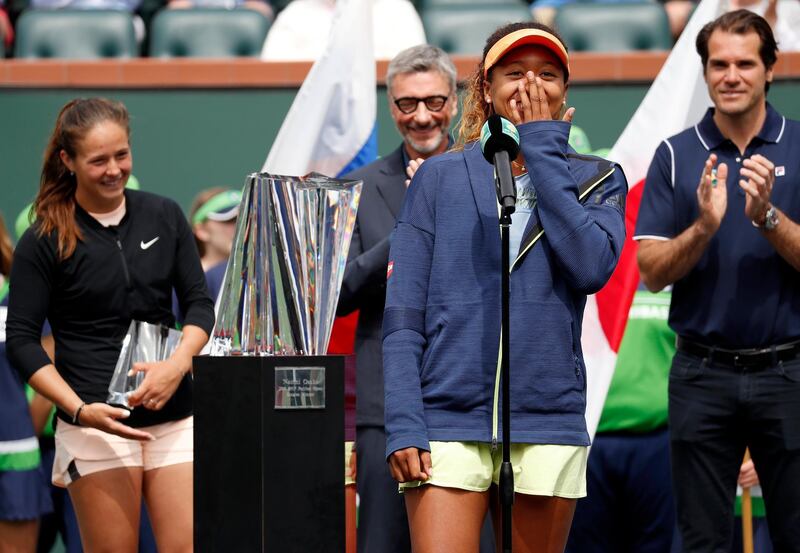“Um, hello … I’m Naom … oh never mind.” Cue nervous giggle. “I’d like to thank the tournament director and the WTA and the staff and the physios … whoops sorry! I’d like to thank Dasha [Kasatkina].” More giggles. “Um, for being super nice and also for being a real cool person to play against … I’d like to thank my team for, um, putting up with me, and yeah that’s basically it.” Another giggle. “I’d also thank to thank my dad, he’s not here, and my mom and sister. They’re watching in Florida, so, hi! Um… who did I forget? I’d like to thank my sponsors too, Adidas, Nissin, Wowow and … um … Yonnex! Ok. Um … what did I forget? Oh, the ball kids and the umpires. The ball kids are super awesome. This is probably going to be, like, the worst acceptance speech of all time.”
"This is probably going to be the worst acceptance speech of all time" - @BNPPARIBASOPEN champion @Naomi_Osaka_
— wta (@WTA) March 18, 2018
We beg to differ! #BNPPO18 pic.twitter.com/4XpckdmLtq
If that made for some disjointed reading, it certainly made for great viewing. Naomi Osaka delivered a refreshingly unscripted winner’s speech at Indian Wells on Sunday that reminded us that a 20-year-old professional athlete can still sometimes be just like any other 20 year old.
Perhaps it is a required reminder, because Osaka had just spent the week doing a fine job resembling a seasoned-pro. Actually, Osaka more closely resembled an established member of the elite, such was the dominant manner in which she dismantled a series of top-ranked opponents en route to her first WTA title.
Former world No 1 Maria Sharapova and Agnieszka Radwanska, previously ranked No 2, provided little resistance in the early rounds. If that pair represent forces of the past, two of the game’s current top stars also had no answer to Osaka’s irresistible combination of power and consistency. World No 5 Karolina Pliskova was comfortably dealt with in the quarter-finals before top-ranked Simona Halep was out-classed in the semis.
The final pitted Osaka against another 20 year old who had breezed past her own share of top players. Daria Kasatkina put out US Open champion Sloane Stephens and world No 2 Caroline Wozniacki, thrashed world No 10 Angelique Kerber, and outlasted seven-time major winner Venus Williams.
____________
Read more:
Serena Williams in Miami the next test for Indian Wells winner Naomi Osaka
Juan Martin del Potro proud to overcome 'bad moments' of injury to win Indian Wells title
[ From Dubai to Indian Wells, Daria Kasatkina faces Naomi Osaka in her second straight final ]
____________
As such it was Kasatkina, finalist in Dubai in her previous outing and ranked 25 places higher than Osaka at No 19, who started the Indian Wells final as slight favourite.
Osaka made a mockery of such pre-match analysis, dismissing the Russian’s challenge in one hour and 12 minutes to clinch the title and confirm what many already believed – that Japan’s best female player has all the hallmarks to become the world’s best female player.
Power and aggression do play key roles in Osaka’s armoury but it is controlled power and measured aggression. Capable of blasting opponents off court, Osaka is more likely to harness her power to take control of points, keep the ball deep, open angles and offload her groundstrokes into open spaces.
Compare that approach to other power-hitters, such as Jelena Ostapenko or Petra Kvitova, where the default setting is to hit winners at the cost of consistency. These players are arguably easier to handle – essentially get balls back in play and allow them to miss.
It helps, too, that Osaka possesses a powerful and consistent serve that can help her dominate service games and get her out of trouble.
Osaka has also now proved that she has the temperament and calmness under pressure to deliver on the biggest stages, against the biggest opponents.
The tennis at @BNPPARIBASOPEN was 🔥🔥🔥🔥, but these shots were hotter than the Indian Wells desert--> https://t.co/0dJexgo9Rt pic.twitter.com/0yyae9QBTg
— wta (@WTA) March 19, 2018
So if Osaka has all the physical and mental attributes of a top player, then why has she loitered around the top 50 mark, until her rise to No 22 this week?
Defeats have often been caused by drops in concentration and intensity levels, and thus her power becomes less controlled, but that can be expected of any young athlete in the infancy of their career. Indeed, she has only been a fully-fledged WTA player for less than three years.
Her next challenge is a fascinating one – she faces former world No 1 Serena Williams in the first round of the Miami Open this week. It may seem remarkable to Osaka coming up against her childhood hero, but as the higher-ranked player and recent winner of a Premier Mandatory event, she will start as the heavy favourite against the great Williams still in the early stages of her comeback.
Osaka’s task now is to find greater consistency, and to convert her obvious talent and skillset into deep runs at tournaments week-in, week-out.
If she can do that, then we better get used to more wonderfully ill-prepared speeches.





